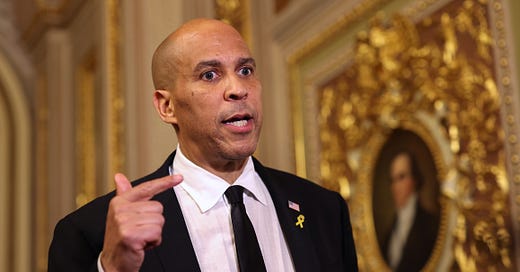
There is probably no easy cure for the Marjorie Taylor Greene phenomenon. That a woman with zero political experience, who inherited a business from her dad and spent her days fantasizing for fringe websites like “American Truth Seekers” and whose sole output consisted of imbecilic conspiracy theories should have been elected to Congress is an indictment of democracy. (I know, I know. ‘Worst form of government except for all the others.’) She’s a repellent clown whose presence on the national stage has yielded nothing but degradation—except for the guffaw she afforded us when denouncing Nancy Pelosi’s “Gazpacho police.”
And she has lots of company. Her colleagues in the House include Paul Gosar and Matt Gaetz and Lauren Bobbert and Louie Gohmert and, sigh, many more. And even among the members who probably do know the difference between the Nazi secret police and a summer soup, there are alarming numbers who are extremist-adjacent. There are, for example, more sitting GOP congressmen who voted not to certify the 2020 election than there are Republicans who voted for a resolution to support NATO.
Democrats are not immune to the extremism virus either. While the Democratic party hasn’t lost its bearings in the way the Republican party has, it is skewed by its own zealots. In the 2020 presidential primaries, for example, progressive activists pushed candidates to impose a moratorium on deportations, to abolish private health insurance, and to ban fracking, among other demands. Both Kamala Harris and Cory Booker pledged to decriminalize illegal border crossing and ban fracking. Elizabeth Warren endorsed reparations for African-Americans and Native Americans, and Pete Buttigieg recommended packing the Supreme Court. Those issues weren’t top of mind for average Democrats, let alone for average voters, yet the candidates were responding to incentives.
In the pre-internet era, our stable political parties seemed to be bulwarks of stability. But that has long since ceased to be the case. Rather than forming, directing, and discipling their members, these institutions have become hollow shells. Unable to control fundraising due to the rise of small-dollar, internet contributions, and stripped even of the formerly coveted power of attaching earmarks to legislation, the parties, as Yuval Levin has argued, are mere soapboxes that permit members to flaunt their personal brands.
It’s actually worse than that. The party duopoly empowers the most extreme voters and leaves the vast middle unrepresented and feeling that in general elections they must choose the lesser of two evils. As Katherine Gehl, founder of the Institute for Political Innovation, notes, about 10 percent of voters (those who vote in primaries) determine the outcome of 83 percent of congressional races. And because primary voters tend to be more ideological and extreme than others, candidates pander to them to get elected and then to remain in office. The term “primary” became a verb only in the last decade or so, as the power of the party zealots became a cudgel to use against any member who even considered compromising with the other party.
There’s one more factor aggravating the lurch to extremism, at least among Republicans (Democrats have different rules) and that’s the winner-take-all system in presidential primaries. In 2016, Donald Trump lost Iowa, and then won New Hampshire with 35 percent of the vote. A solid majority, 57 percent, was divided among five other candidates. In South Carolina, Trump won the state with 32.5 percent, with five others dividing up 67.4 percent. This pattern continued. Ted Cruz actually won Wisconsin in April. But toward the end, the accumulation of winner-take-all delegates made Trump’s victory inevitable and voters jumped on the winning train.
So, are we doomed to be at the mercy of the mad and bad? It’s possible, but then again, one reform that seems to be getting traction is ranked-choice voting (also known as instant runoff elections).
It’s already the law in Alaska and Maine for state, congressional, and presidential contests and has been adopted by more than 20 cities. In Virginia, the Republican party used a ranked-choice system to choose its gubernatorial candidate in 2021, with the result that Glenn Youngkin rather than Amanda Chase (“Trump in heels”) secured the nomination. In New York City, predictions that the city’s 5.6 million voters would find the ranked-choice system confusing were not borne out. Turnout was up compared with the last contested mayoral primary, and 95 percent of voters said the system was easy. There were no differences among ethnic groups in understanding the system, and the winner was a moderate former cop.
There are many different approaches to ranked-choice voting, and experimentation will determine which is best. But even with the small sample we have, we can judge that the incentives seem better. Among the three GOP senators who voted to confirm Ketanji Brown Jackson to the Supreme Court, only one is up for reelection in 2022—Lisa Murkowski of Alaska. Brown’s politics may not be Murkowski’s, but Jackson is clearly qualified and it’s good to uphold the tradition that the president should get his pick barring some scandal or malfeasance. Murkowski could uphold this norm and not fear a Trumpist primary challenger because Alaska now holds an open primary in which anyone from any party can participate. The four candidates who win the most votes go on to the general election. Voters rank their choices. If one candidate gets over 50 percent, he or she is the winner. If not, the bottom polling candidate is dropped and the second choices on ballots are distributed and so on until someone has a majority.
Not only does the ranked-choice system disempower party extremists, it also discourages candidates from savage personal attacks, the persistence of which arguably keeps some fine people out of politics altogether. Candidates are less likely to attack one another if they hope to be the second choice of the other person’s voters.
The two-party system has not proven to be a solid foundation for democracy. Time to disarm the crazies.











